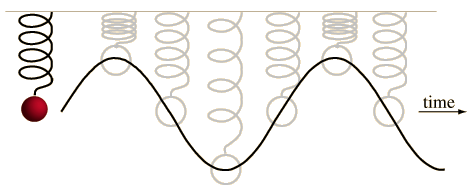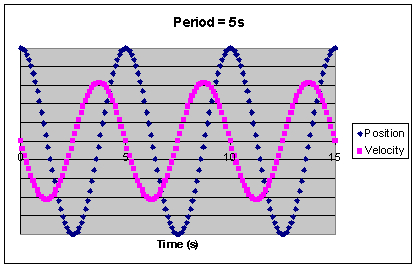



An object moving along the x-axis is said to exhibit simple harmonic motion if its position as a function of time varies as
x(t) = x0 + A cos(ωt + φ).
The object oscillates about the equilibrium position x0. If we choose the origin of our coordinate system such that x0 = 0, then the displacement x from the equilibrium position as a function of time is given by
x(t) = A cos(ωt + φ).
A is the amplitude of the oscillation, i.e. the maximum displacement of the object from equilibrium, either in the positive or negative x-direction. Simple harmonic motion is repetitive. The period T is the time it takes the object to complete one oscillation and return to the starting position. The angular frequency ω is given by ω = 2π/T. The angular frequency is measured in radians per second. The inverse of the period is the frequency f = 1/T. The frequency f = 1/T = ω/2π of the motion gives the number of complete oscillations per unit time. It is measured in units of Hertz, (1 Hz = 1/s).
The velocity of the object as a function of time is given by
v(t) = -ω A sin(ωt + φ),
and the acceleration is given by
a(t) = -ω2A cos(ωt + φ) = -ω2x.
The quantity φ is called the phase constant. It is determined by the initial conditions of the motion. If at t = 0 the object has its maximum displacement in the positive x-direction, then φ = 0, if it has its maximum displacement in the negative x-direction, then φ = π. If at t = 0 the particle is moving through its equilibrium position with maximum velocity in the negative x-direction then φ = π/2. The quantity ωt + φ is called the phase.
In the figure below position and velocity are plotted as a function of time for oscillatory motion with a period of 5 s. The amplitude and the maximum velocity have arbitrary units. Position and velocity are out of phase. The velocity is zero at maximum displacement, and the displacement is zero at maximum speed.

For simple harmonic motion, the acceleration a = -ω2x is proportional to the displacement, but in the opposite direction. Simple harmonic motion is accelerated motion. If an object exhibits simple harmonic motion, a force must be acting on the object. The force is
F = ma = -mω2x.
It obeys Hooke's law, F = -kx, with k = mω2.
External link: Simple harmonic motion (Youtube)
The force exerted by a spring obeys Hooke's law. Assume that an object is attached to a spring, which is stretched or compressed. Then the spring exerts a force on the object. This force is proportional to the displacement x of the spring from its equilibrium position and is in a direction opposite to the displacement.
F = -kx
Assume the spring is stretched a distance A from its equilibrium position and then released. The object attached to the spring accelerates as it moves back towards the equilibrium position.
a = -(k/m)x
It gains speed as it moves towards the equilibrium position because its acceleration is in the direction of its velocity. When it is at the equilibrium position, the acceleration is zero, but the object has maximum speed. It overshoots the equilibrium position and starts slowing down, because the acceleration is now in a direction opposite to the direction of its velocity. Neglecting friction, it comes to a stop when the spring is compressed by a distance A and then accelerates back towards the equilibrium position. It again overshoots and comes to a stop at the initial position when the spring is stretched a distance A. The motion repeats. The object oscillates back and forth. It executes simple harmonic motion. The angular frequency of the motion is
ω = √(k/m),
the period is
T = 2π√(m/k),
and the frequency is
f = (1/(2π))√(k/m).
Summary:If the only force acting on an object with mass m is a Hooke's law force, x(t) = Acos(ωt + φ), A = amplitude |
A particle oscillates with simple harmonic motion, so that its
displacement varies according to the expression x = (5 cm)cos(2t + π/6)
where x is in centimeters and t is in seconds. At t = 0 find
(a) the displacement of the particle,
(b)
its velocity, and
(c) its acceleration.
(d) Find the period and amplitude of the motion.
Solution:
A 20 g particle moves in simple harmonic motion with a frequency of 3
oscillations per second and an amplitude of 5 cm.
(a) Through what total distance does the particle move during one cycle of
its motion?
(b) What is its maximum speed? Where does that occur?
(c) Find the maximum acceleration of the particle. Where in the motion does
the maximum acceleration occur?
Solution:
Assume a mass suspended from a vertical spring of spring constant k. In equilibrium the spring is stretched a distance x0 = mg/k. If the mass is displaced from equilibrium position downward and the spring is stretched an additional distance x, then the total force on the mass is mg - k(x0 + x) = -kx directed towards the equilibrium position. If the mass is displaced upward by a distance x, then the total force on the mass is mg - k(x0 - x) = kx, directed towards the equilibrium position. The mass will execute simple harmonic motion. The angular frequency ω = SQRT(k/m) is the same for the mass oscillating on the spring in a vertical or horizontal position. But the equilibrium length of the spring about which it oscillates is different for the vertical position and the horizontal position.
Assume an object attached to a spring exhibits simple harmonic motion. Let one end of the spring be attached to a wall and let the object move horizontally on a frictionless table.
The object's kinetic energy is
K = ½mv2 = ½mω2A2sin2(ωt + φ).
Its potential energy is elastic potential energy. The elastic potential energy stored in a spring displaced a distance x from its equilibrium position is U = ½kx2. The object's potential energy therefore is
U = ½kx2 = ½mω2x2 = ½mω2A2cos2(ωt + φ).
The total mechanical energy of the object is
E = K + U = ½mω2A2(sin2(ωt + φ) + cos2(ωt + φ)) = ½mω2A2.
The energy E in the system is proportional to the square of the amplitude.
E = ½kA2.
It is a continuously changing mixture of kinetic energy and potential energy.
For any object executing simple harmonic motion with angular frequency ω, the restoring force F = -mω2x obeys Hooke's law, and therefore is a conservative force. We can define a potential energy U = ½mω2x2, and the total energy of the object is given by E = ½mω2A2. Since vmax = ωA, we can also write E = ½mvmax2.
A particle that hangs from a spring oscillates with an angular frequency of 2
rad/s. The spring is suspended from the ceiling of an elevator car and hangs
motionless (relative to the car) as the car descends at a constant speed of 1.5
m/s. The car then suddenly stops. Neglect the mass of the spring.
With what amplitude does the particle oscillate?
Solution:
A mass-spring system oscillates with an amplitude of 3.5 cm. If the force
constant of the spring of 250 N/m and the mass is 0.5 kg, determine
(a) the mechanical energy of the system,
(b) the maximum speed of the mass, and
(c) the maximum acceleration.
Solution: